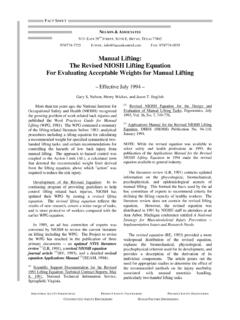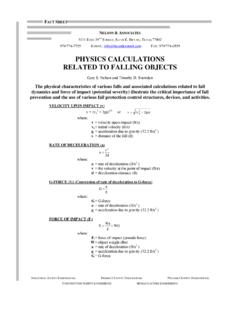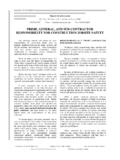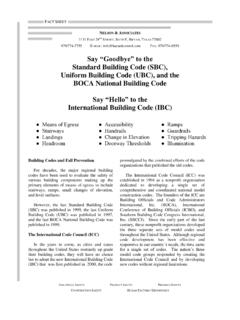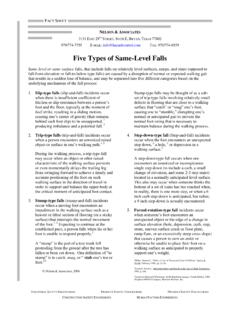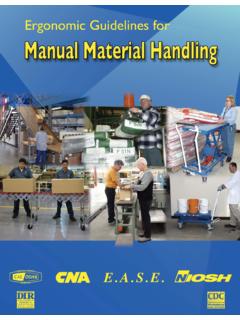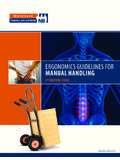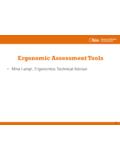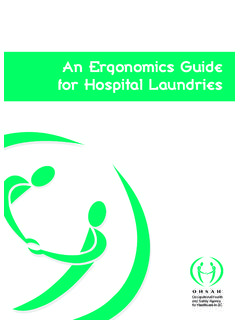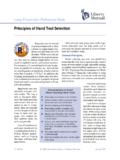Transcription of Manual Lifting: The NIOSH Work Practices Guide …
1 FACT SHEET NELSON & ASSOCIATES 3131 EAST 29TH STREET, SUITE E, BRYAN, TEXAS 77802 979/774-7755 E-MAIL: FAX: 979/774-0559 INDUSTRIAL SAFETY ENGINEERING PRODUCT SAFETY ENGINEERING PREMISES SAFETY ENGINEERING CONSTRUCTION SAFETY ENGINEERING HUMAN FACTORS ENGINEERING Manual lifting : The NIOSH work Practices Guide for Manual lifting Determining Acceptable Weights of Lift -- Effective from March 1981 to July 1994 -- Gary S. Nelson, Henry Wickes, and Jason T. English In the past, efforts to control back injuries largely focused on the limited recommendations to "lift with your legs, and not your back," and "keep your back straight.
2 " Comparatively little attention was given to available research related to acceptable weights of lift until 1981, when the National Institute for Occupational Safety and Health ( NIOSH ) published a landmark technical report entitled work Practices Guide for Manual lifting . The NIOSH Guide presents us with one unified set of Manual lifting recommendations based on the convergence of medical, scientific, and engineering points of view. Such convergence, bolstered by post-publication studies that have further validated the Guide , has established the 1981 NIOSH work Practices Guide for Manual lifting as the preeminent ergonomic authority for the determination of acceptable weights of Manual lift.
3 Unlike the arbitrary and largely ineffective recommendations of the past, the NIOSH Guide can assist in determining which lifts are "safe" (that is, which lifts are associated with an acceptable risk) and which lifts are "unsafe" (that is, which lifts are associated with an unacceptable risk). With the help of the NIOSH Guide , employers can inventory lifting tasks assigned to their employees and then implement reasonable steps to control lifting related back injuries. Using the same guidelines, manufacturers can recognize the risk of back injury associated with their products and then design their products to eliminate such risk or properly label their products to warn and instruct about proper methods of lift.
4 In 1985, NIOSH convened an ad hoc committee of experts to revise and expand the NIOSH equation for the design and evaluation of Manual lifting tasks. According to NIOSH , the revised equation "..reflects new findings and provides methods for evaluating asymmetrical lifts, lifts of objects with less than optimal hand-container couplings, and also provides guidelines for a larger range of work durations and lifting frequencies than the 1981 equation." The revised equation was developed in 1991 and published in July 1993. There is little doubt that future field studies will validate the 1991 equation as the 1981 equation has been validated in the past.
5 JOB RISK FACTORS Many aspects of the physical act of lifting a load have been identified as potentially hazardous to a person's musculoskeletal system. Job risk factors defined by the Guide include: 1. Weight - force required. 2. Location/Site - load center of gravity with respect to the worker. 3. Frequency/duration/pace - temporal aspects of the task in terms of repetitiveness of handling. 4. Stability - Consistency in location of load center of gravity as in handling bulky or liquid materials. 5. Coupling - texture, handle size and location, shape, etc. 2 6. Workplace geometry - spatial aspects of the task in terms of movement distance, direction, obstacles, postural constraints, etc.
6 7. Environment - factors such as temperature, humidity, illumination, noise, vibration, frictional stability of the foot, etc. The first three "job risk factors" have received sufficient attention in lifting injury research to form a mathematical basis for guidance. These three comprise the " lifting task variables." Properly applied, these variables can form the basis for establishing acceptable versus unacceptable lifting task limits. This will be explained by example on pages 3 and 4. Before limits are determined, however, there is an important caveat which must be understood.
7 lifting limits based on the " lifting task variables" are valid only in the absence of extraneous risks defined by job risk factors 4 through 7. The Guide assumes "ideal" lifting conditions including a stable load, a smooth two-handed symmetrical lift with a natural and comfortable grip or handhold (called a "good coupling") on an object of moderate width. The Guide also calls for a natural, unrestricted lifting posture, good footing, a favorable ambient environment (moderate temperature and humidity, good lighting, absence of high noise or vibration, etc.)
8 , absence of twisting during the lifting process, and a minimum of other Manual activities associated with the lifting task (such as pushing, pulling, carrying, holding, etc.). Thus, a lifting task that might be acceptable for a given weight under favorable conditions could be unacceptable under actual conditions found in some workplaces. Conditions that would lower an otherwise acceptable (limit for) weight of lift would include elements of the lifting task involving twisting motions, a restrictive lifting posture, the carrying of objects on stairs or over obstacles, slippery footing, or hot environments.
9 TASK EVALUATION A simple algebraic formula is provided in the NIOSH Guide for evaluating specified Manual lifting tasks based on the " lifting task variables." Two limits are defined by the Guide for each particular task. These are the Action Limit (AL) and the Maximum Permissible Limit (MPL). Depending on these limits, every task will fall into one of the following three distinct categories. 1. Tasks That Are Below the Action Limit. Such tasks represent a nominal risk to most workers. More than 99% of male workers and over 75% of female workers have the strength to lift this much weight.
10 2. Tasks that are above the Action Limit. These tasks present an unacceptable risk to most workers without administrative or engineering controls. (Engineering controls are always preferred.) Where engineering controls are difficult to achieve, management may chose to utilize administrative controls to protect workers. Administrative controls include action taken by management to match job requirements to individual worker capabilities through carefully administered worker strength and aerobic capacity testing, and training programs that teach workers the use of techniques that minimize physical stress and the basic Manual lifting concepts necessary to determine the difference between a safe and an unsafe lift.
